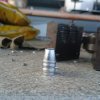Spindrift
Well-Known Member
Just picked up this Lachmiller 429-240GC. With Lyman handles, maybe? If I have got it right, Lachmiller made moulds in the late sixties and seventies, before RCBS bought their business. I got it at a bargain price, feels like I paid for no more than the handles. It has seen a bit of use, but no abuse it seems. Things that should move, moves smoothly. Things that shouldn’t move, is rock solid. No rust or defects.
This is actually my first iron mould (!), and I have a newbie question.
Would two-stroke oil be a suitable preservant to prevent rust?
Ok, time to fire up the pot (lead pot, that is)




This is actually my first iron mould (!), and I have a newbie question.
Would two-stroke oil be a suitable preservant to prevent rust?
Ok, time to fire up the pot (lead pot, that is)




